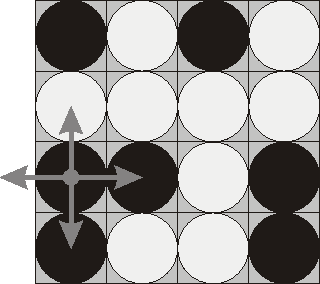题目链接:POJ 1753
Problem Description
Flip game is played on a rectangular 4x4 field with two-sided pieces placed on each of its 16 squares. One side of each piece is white and the other one is black and each piece is lying either it’s black or white side up. Each round you flip 3 to 5 pieces, thus changing the color of their upper side from black to white and vice versa. The pieces to be flipped are chosen every round according to the following rules:
Choose any one of the 16 pieces.
Flip the chosen piece and also all adjacent pieces to the left, to the right, to the top, and to the bottom of the chosen piece (if there are any).
Consider the following position as an example:
bwbw
wwww
bbwb
bwwb
Here “b” denotes pieces lying their black side up and “w” denotes pieces lying their white side up. If we choose to flip the 1st piece from the 3rd row (this choice is shown at the picture), then the field will become:
bwbw
bwww
wwwb
wwwb
The goal of the game is to flip either all pieces white side up or all pieces black side up. You are to write a program that will search for the minimum number of rounds needed to achieve this goal.
Input
The input consists of 4 lines with 4 characters “w” or “b” each that denote game field position.
Output
Write to the output file a single integer number - the minimum number of rounds needed to achieve the goal of the game from the given position. If the goal is initially achieved, then write 0. If it’s impossible to achieve the goal, then write the word “Impossible” (without quotes).
Sample Input
1 | bwwb |
Sample Output
1 | 4 |
Solution
题意
给定 4 * 4 的正方形,每个格子要么是黑色,要么是白色,可以改变任意的格子的颜色,其上下左右的格子也会改变,问至少改变几个格子可以使正方形变为全黑或者全白。
思路
DFS
- 每个格子要么不翻,要么翻 1 次。(翻奇数次和翻 1 次效果相同,翻偶数次和不翻效果一样)
- 可以选择翻转 0 个、1 个、2 个、3 个 … 16 个
- 每次翻完后判断是否为纯色,如果为纯色就输出相应的格子个数,如果 16 个翻转了还不是纯色,就输出“impossible”。
Code
1 |
|
